7 Emails Your Nonprofit Can Send During the COVID-19 Outbreak

The COVID-19 (coronavirus) outbreak has forced a massive shift in the way nonprofits operate day to day. Aside from all the changes your nonprofit might have to make internally, you must also figure out your strategy to maintain email marketing during a pandemic so that your supporters are well-informed of any major changes and what the future holds.
Whether you want to update your community on changes to your fundraising events, send a message of thanks, or simply greet them, it’s important now, more than ever, to send well-crafted emails that not only keep your supporters informed, but also keep your nonprofit top of mind during the tumult of a global event.
Below, we showcase seven types of emails that we’ve seen from nonprofits responding to the coronavirus. They’re great examples of content that you can send right now to activate donors, drive virtual event participation, motivate your community, and more.
Free Download: 9 Email Templates to Engage Donors Year-Round
1. Timely Responses
When an unexpected event or disaster occurs, people expect to hear your response to the initial situation in a timely fashion. As part of your email marketing during a pandemic, you need to reach out as news continues to develop around the issue.
Without a commitment to ongoing messaging, or if you take too long to send emails related to a timely situation, it can upset your audience and break down the trust you’ve worked so hard to establish. They’re looking to you for answers, so be clear, thoughtful, and provide a timeline for when they can expect to hear more from you.
When Grassroots Soccer International responded to the coronavirus outbreak, they immediately sent out an email informing everyone how they would respond to the situation—by prioritizing people, impact, and partnership. The email ends by setting expectations on a general timeline for future communications.
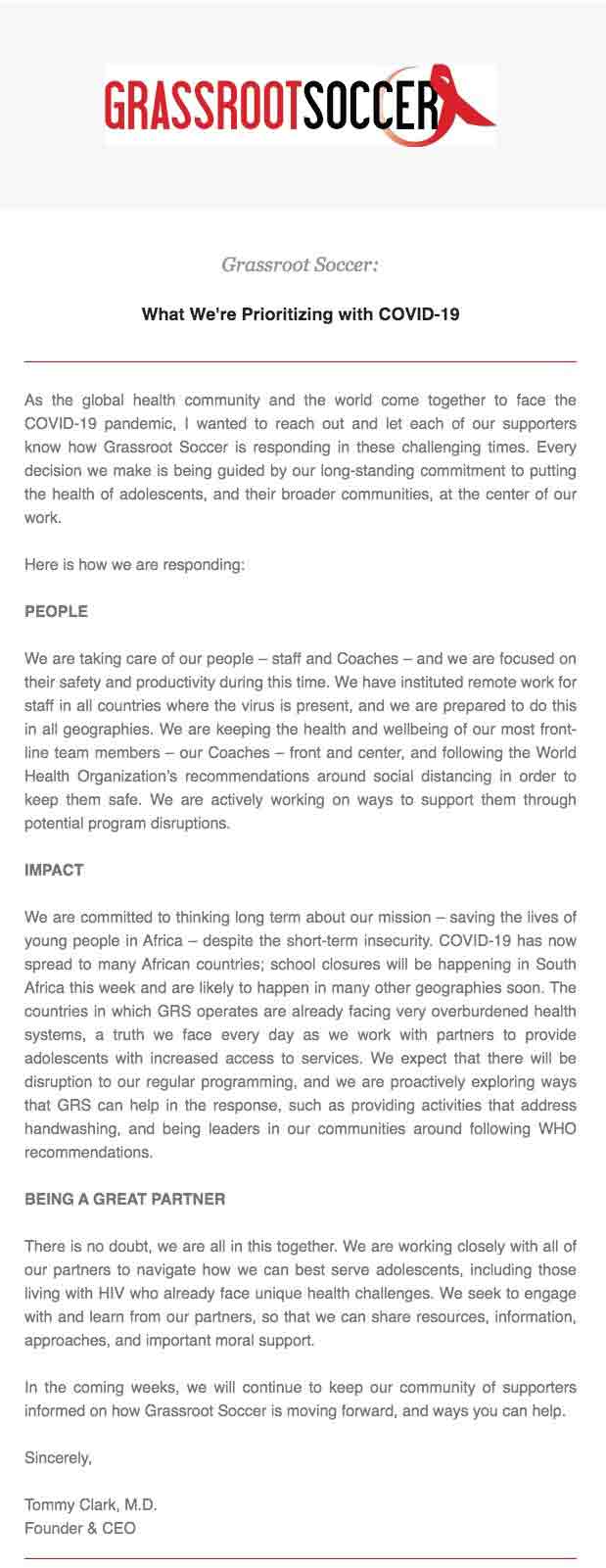
2. Message of Thanks
Typically, your nonprofit thanks donors when they take action on your behalf, such making a gift, creating a personal fundraising page, or making a recurring donation. While you should definitely maintain this practice, a message of thanks can also be a great way to touch base with your entire community, show up in their inbox, and let them know you appreciate their continued support.
Heifer International sent out the timely email below acknowledging the coronavirus outbreak, communicating its impact on their work, and expressing confidence and gratitude as they face this situation because of their donors’ continued support.
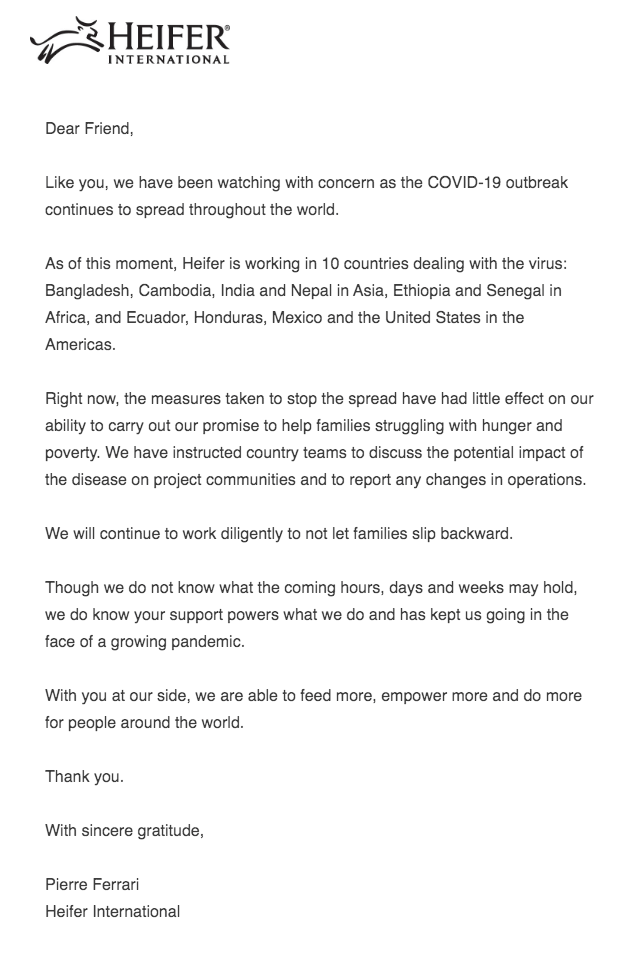
3. Event Updates
Many nonprofits are having to shift their auctions, galas, endurance events, and more into virtual events because of the coronavirus pandemic. When making this transition, no matter what your event is, you must structure your email communications to be clear, concise, and informative.
Walk With Sally made the decision to transition their Friendship Bowl into a fully virtual event. They explain why they made the change in their email, as well as reiterate the several ways supporters can take action—by making a donation to the campaign, participating in their live auction, and joining their virtual event as they broadcast live on their social channels.
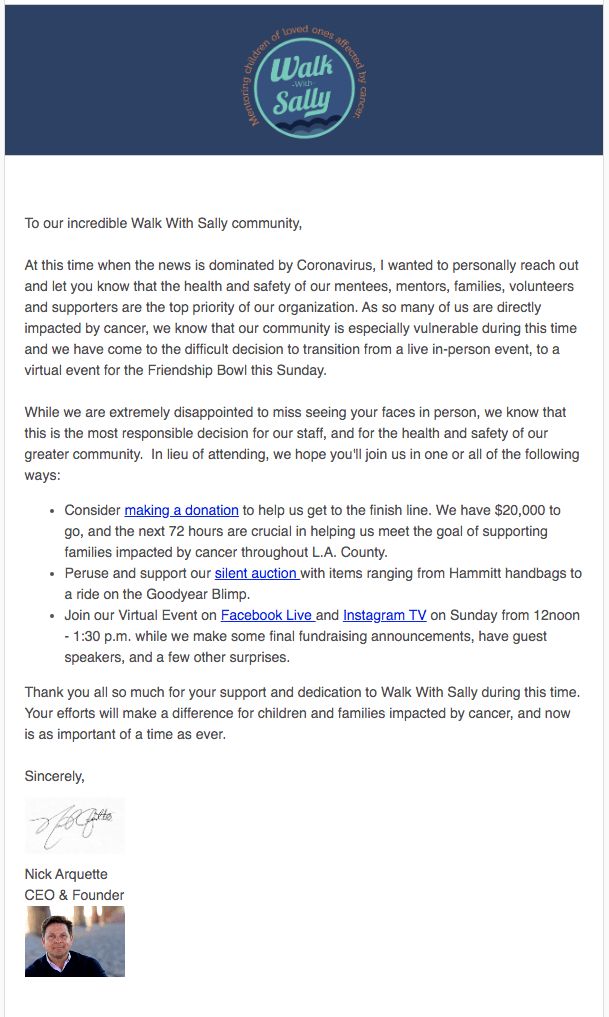
Upaya Social Ventures decided to transition their annual gala into a fully virtual event. Similar to Walk with Sally, they sent consistent and strong communications about the transition to a virtual event and how supporters could get involved. As a result, they were able to pass their fundraising goal of $200,000 to raise over $280,000.
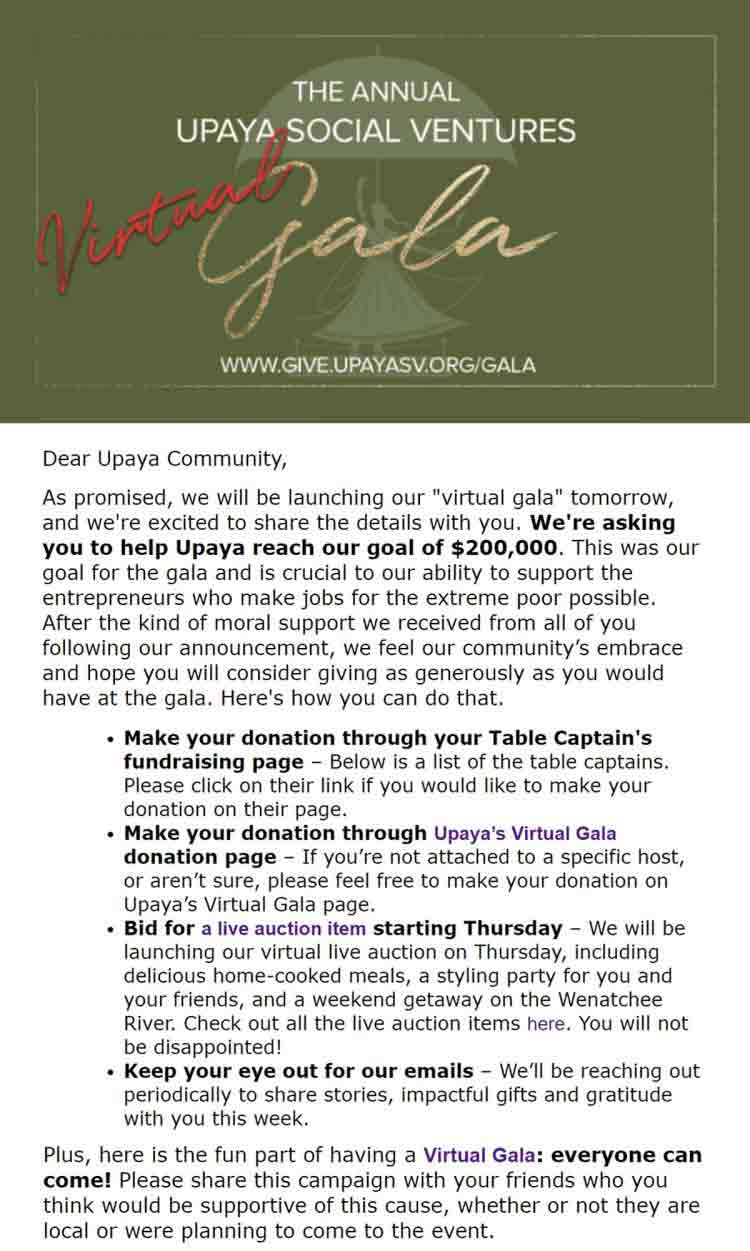
4. Impact
It’s a general best practice to remind your supporters of your mission and how critical their support is for your work year-round, but it’s absolutely crucial while sustaining your email marketing during a pandemic. With the coronavirus outbreak, communicate how your organization can have a direct impact on those affected.
The email from Water4 below is focused purely on impact, posing a serious question with the subject line: “What if you can’t wash your hands? – COVID-19 & Water4.” It’s immediately attention-grabbing, and the body of the email further explains how lack of access to water can hurt communities during this time.
Then, it follows up with a section on how Water4 makes a difference, why their work is more important than ever, and how taking action today can further their mission.
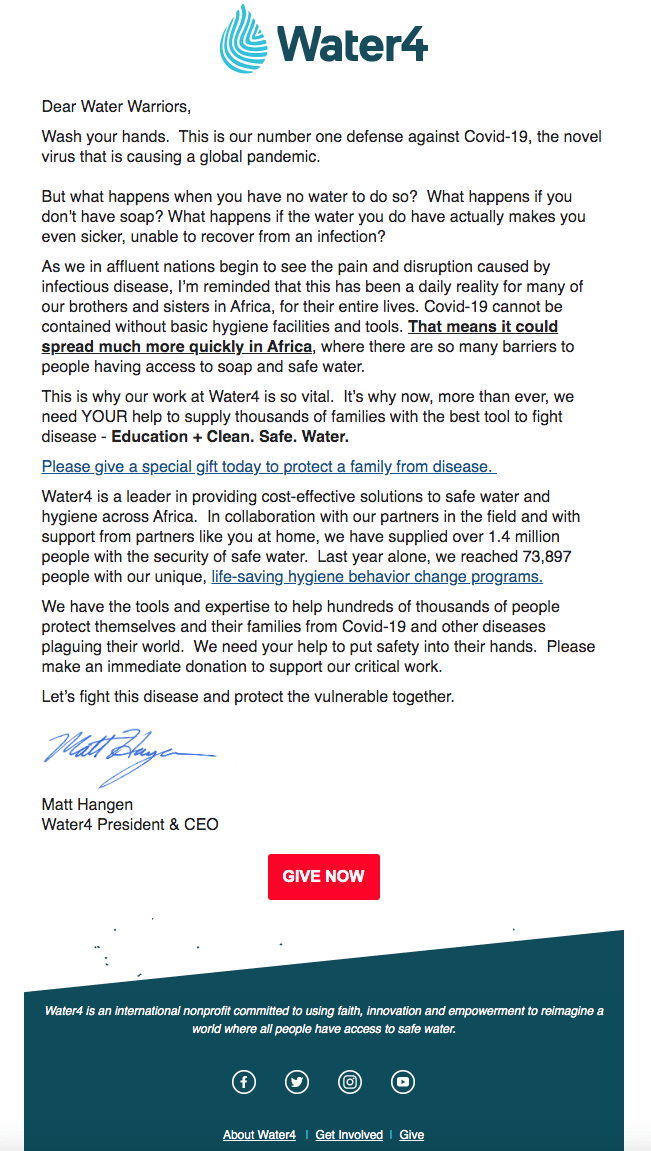
5. Recommit to Your Why
When the chips are down, your “why” is what rallies people to your cause, inspires your supporters, and carries you through difficult situations. Like The Trevor Project shows us, there’s power in sharing this motivation with your audience.
Right off the bat, you’ll notice they lead with their powerful mission statement to set the tone of the message as it relates to the pandemic: “The Trevor Project’s mission is to save LGBTQ young lives and provide them support in all moments of crisis—including anxiety, worries, and uncertainty about this growing global pandemic.” From there, they detail the specific measures being taken to both adapt to the pandemic operationally, and still ensure their mission—powered by their why—remains top of mind.
Consider how you can communicate to your supporters your “why,” and how the actions you’re taking to adapt to the coronavirus outbreak—and the actions you’re asking your supporters to take—ladder back up to it. Re-inspire and rally your community around the reason why they became passionate about your organization in the first place.
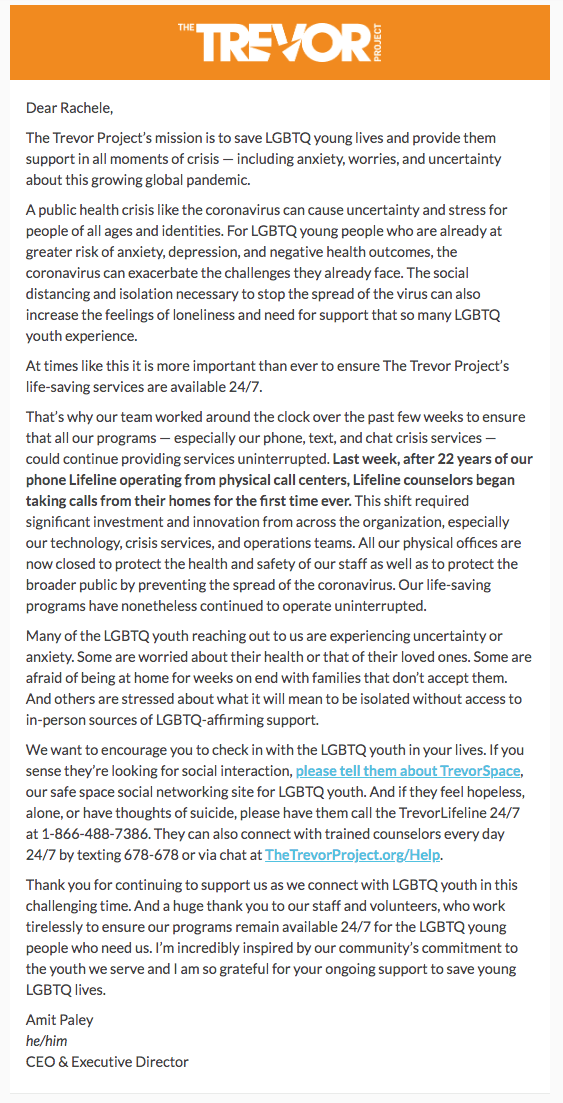
6. Inspirational Messages
Throughout any emergency, disaster, or other major situation, never forget that you’re a pillar of strength for the community that supports you. An inspirational message of hope can go a long way in giving people peace of mind, while also reigniting their passion for supporting your nonprofit in the first place.
More importantly, it establishes a sense of community around your mission, work, and programs. This can foster trust between your organization and supporters, and help establish them as lifelong members.
For example, To Write Love on Her Arms (TWLOHA) sent a message that’s bold and inspirational that leads with, “Fear Won’t Win.” They detail why the coronavirus outbreak won’t stop them or their supporters as they continue to march forward.
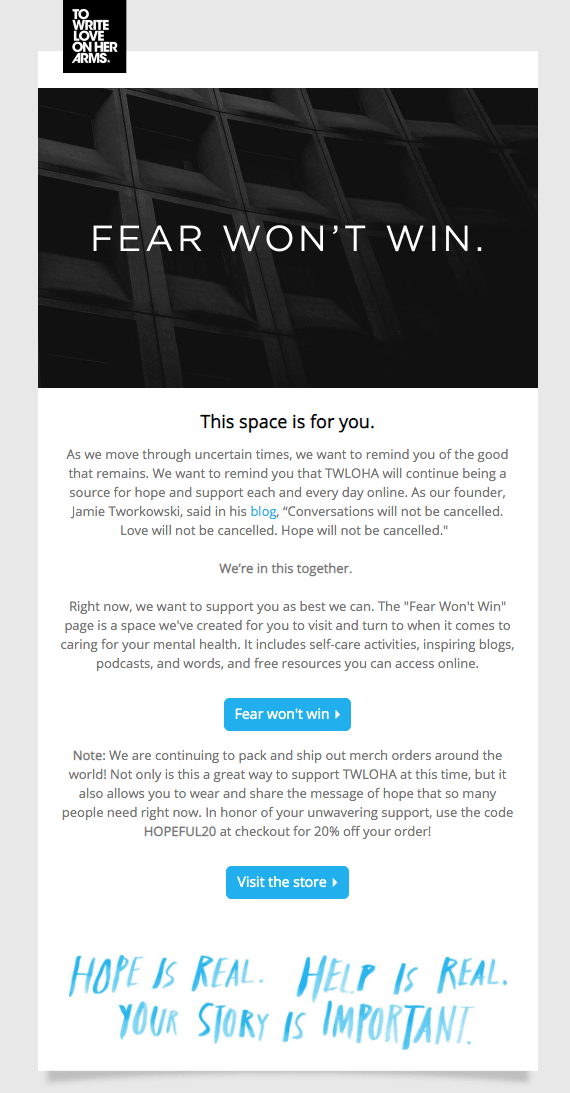
7. Provide Resources
While you navigate the waters of major world events, disasters, or unexpected situations, you can stay on people’s radars by offering resources for your community. It’s one way you can give back to those who give to you year-round, and it shows that you’re there for them during a difficult time.
For example, if you’re a fitness organization, you can provide free workout plans, livestream group workouts, or send daily video inspiration. Take your nonprofit’s niche focus and develop something you can send to supporters that helps take their mind off things, while also strengthening your overall sense of community.
LoveYourBrain sent an email that described their commitment to yoga, mindfulness, and community and offered virtual programs, daily meditation sessions, and a library of yoga videos for anyone to access.
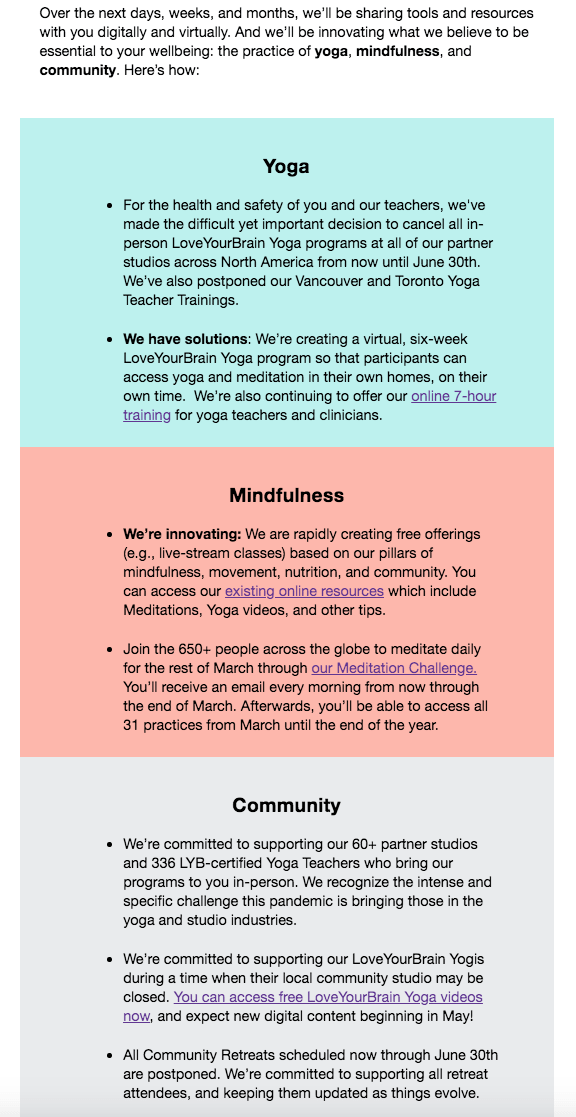
Your nonprofit needs to be thoughtful and creative in its approach to email marketing during a pandemic. Use these examples to diversify your messages and continuously deliver relevant information, resources, and opportunities to your supporters during the coronavirus outbreak and year-round.
If you’d like to strengthen your email strategy further, download our free 9 Email Templates for Annual Communications for more ideas on when and how you can touch base with your community.
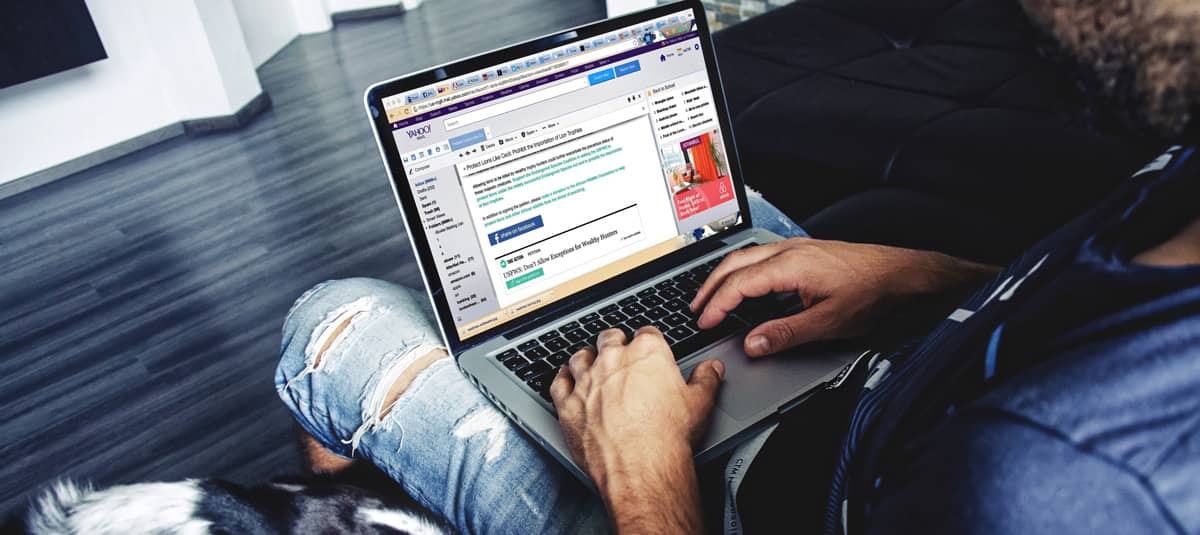
9 Email Templates for Nonprofit Annual Communication Plan



